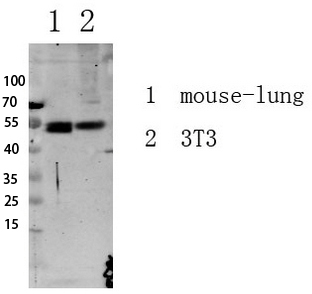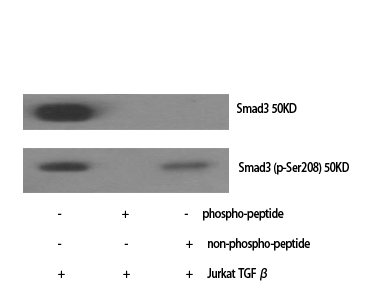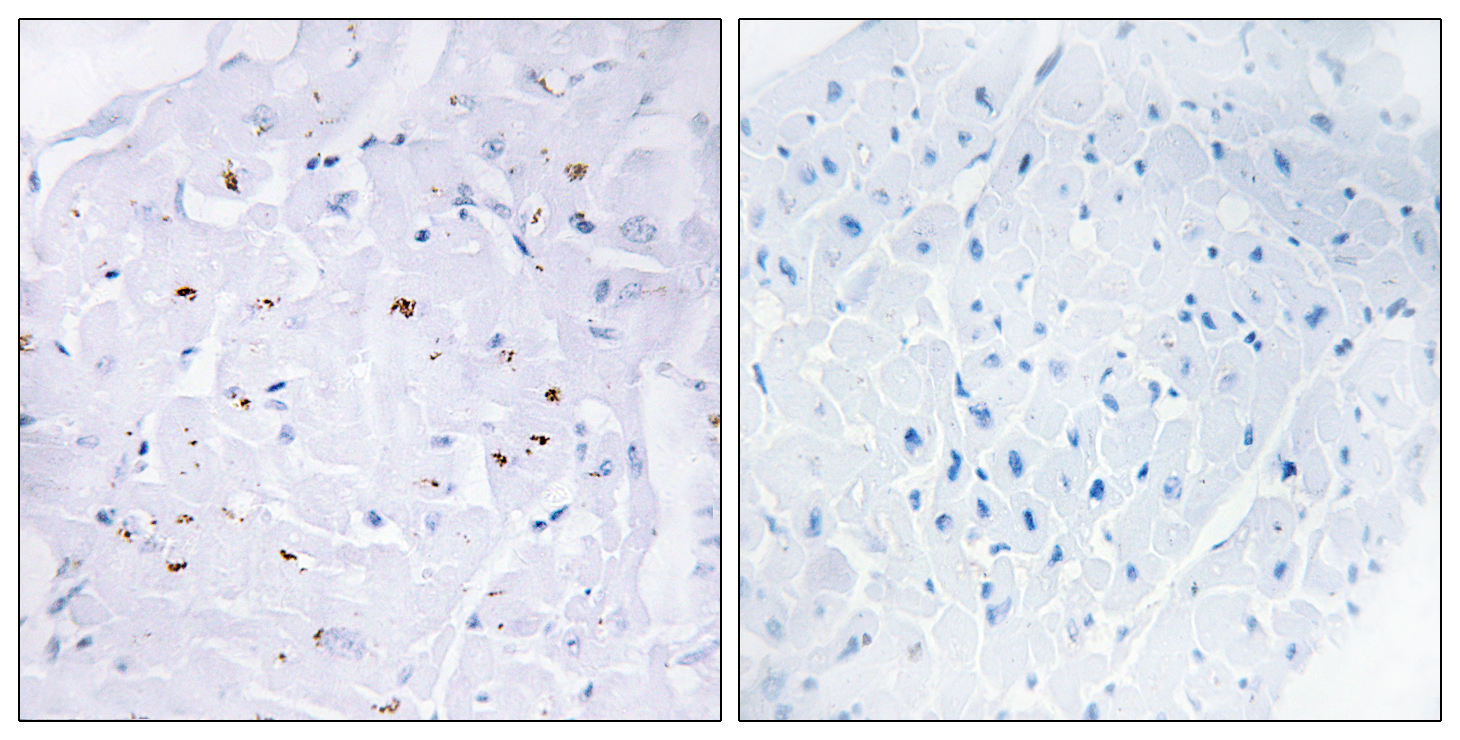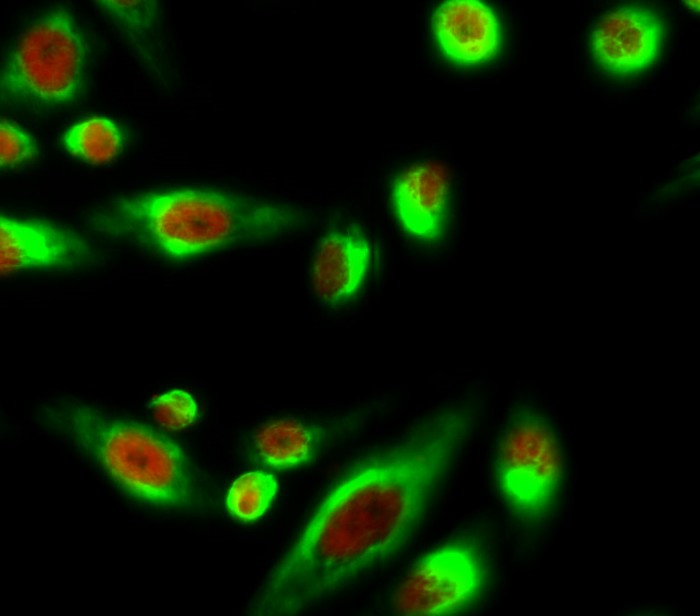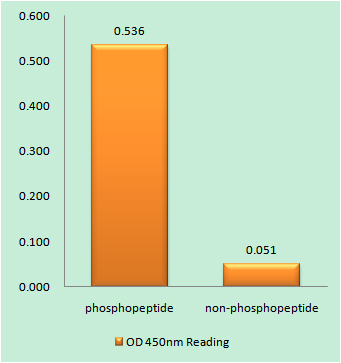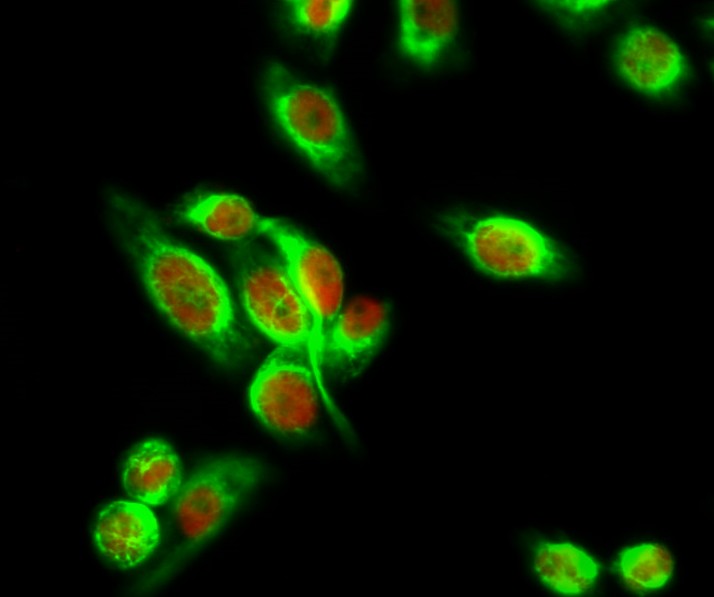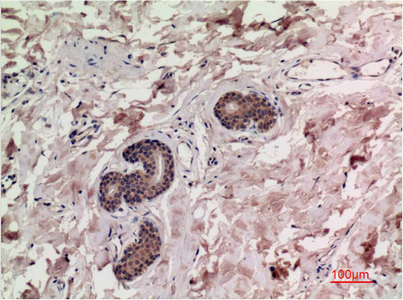
Catalog: YM8682
Size
Price
Status
Qty.
200μL
$600.00
3 weeks
0
100μL
$340.00
3 weeks
0
40μL
$190.00
3 weeks
0
Add to cart


Collected


Collect
Main Information
Target
Smad3
Host Species
Rabbit
Reactivity
Human, Mouse, Rat
Applications
WB, IHC, IF, IP, ELISA
MW
48kD (Calculated)
52kD (Observed)
Conjugate/Modification
Phospho
Detailed Information
Recommended Dilution Ratio
IHC 1:200-1:1000; WB 1:2000-1:10000; IF 1:200-1:1000; ELISA 1:5000-1:20000; IP 1:50-1:200;
Formulation
PBS, 50% glycerol, 0.05% Proclin 300, 0.05%BSA
Specificity
Phospho-Smad3 (S423/S425) Antibody detects endogenous levels of Smad3 protein only when phosphorylated at S423/425.The name of modified sites may be influenced by many factors, such as species (the modified site was not originally found in human samples) and the change of protein sequence (the previous protein sequence is incomplete, and the protein sequence may be prolonged with the development of protein sequencing technology). When naming, we will use the "numbers" in historical reference to keep the sites consistent with the reports. The antibody binds to the following modification sequence (lowercase letters are modification sites):CSSVs
Purification
Protein A
Storage
-15°C to -25°C/1 year(Do not lower than -25°C)
MW(Calculated)
48kD
MW(Observed)
52kD
Modification
Phospho
Clonality
Monoclonal
Clone Number
PT0913R
Isotype
IgG,Kappa
Related Products
Antigen&Target Information
Specificity:
Phospho-Smad3 (S423/S425) Antibody detects endogenous levels of Smad3 protein only when phosphorylated at S423/425.The name of modified sites may be influenced by many factors, such as species (the modified site was not originally found in human samples) and the change of protein sequence (the previous protein sequence is incomplete, and the protein sequence may be prolonged with the development of protein sequencing technology). When naming, we will use the "numbers" in historical reference to keep the sites consistent with the reports. The antibody binds to the following modification sequence (lowercase letters are modification sites):CSSVs
show all
Gene Name:
SMAD3 MADH3
show all
Protein Name:
Mothers against decapentaplegic homolog 3
show all
Other Name:
SMAD3 ;
MADH3 ;
Mothers against decapentaplegic homolog 3 ;
MAD homolog 3 ;
Mad3 ;
Mothers against DPP homolog 3 ;
hMAD-3 ;
JV15-2 ;
SMAD family member 3 ;
SMAD 3 ;
Smad3 ;
hSMAD3
MADH3 ;
Mothers against decapentaplegic homolog 3 ;
MAD homolog 3 ;
Mad3 ;
Mothers against DPP homolog 3 ;
hMAD-3 ;
JV15-2 ;
SMAD family member 3 ;
SMAD 3 ;
Smad3 ;
hSMAD3
show all
Database Link:
Background:
The protein encoded by this gene belongs to the SMAD, a family of proteins similar to the gene products of the Drosophila gene 'mothers against decapentaplegic' (Mad) and the C. elegans gene Sma. SMAD proteins are signal transducers and transcriptional modulators that mediate multiple signaling pathways. This protein functions as a transcriptional modulator activated by transforming growth factor-beta and is thought to play a role in the regulation of carcinogenesis. [provided by RefSeq, Apr 2009],
show all
Function:
Disease:Defects in SMAD3 may be a cause of colorectal cancer (CRC) [MIM:114500].,Domain:The MH2 domain is sufficient to carry protein nuclear export.,Function:Transcriptional modulator activated by TGF-beta (transforming growth factor) and activin type 1 receptor kinase. SMAD3 is a receptor-regulated SMAD (R-SMAD).,PTM:Phosphorylated on serine by TGF-beta and activin type 1 receptor kinases.,similarity:Belongs to the dwarfin/SMAD family.,similarity:Contains 1 MH1 (MAD homology 1) domain.,similarity:Contains 1 MH2 (MAD homology 2) domain.,subcellular location:In the cytoplasm in the absence of ligand. Migration to the nucleus when complexed with Smad4.,subunit:Interacts with HGS. Interacts with NEDD4L in response to TGF-beta. Interacts with TTRAP (By similarity). Interacts with SARA (SMAD anchor for receptor activation); form trimers with another SMAD3 and the co-SMAD SMAD4. Interacts with JUN/FOS, vitamin D receptor, homeobox protein TGIF and TGIF2, PEBP2-alpha C subunit, CREB-binding protein (CBP), p300, SKI, SNON, ATF2, SMURF2, AIP1, DACH1 and TGFB1I1. Part of a complex consisting of AIP1, ACVR2A, ACVR1B and SMAD3. Found in a complex with SMAD2 and TRIM33 upon addition of TGF-beta. Interacts with SMAD2 and TRIM33. Found in a complex with SMAD3, Ran and XPO4. Interacts with XPO4. Interacts with LBXCOR1 and CORL2.,
show all
Cellular Localization:
Cytoplasm . Nucleus . Cytoplasmic and nuclear in the absence of TGF-beta. On TGF-beta stimulation, migrates to the nucleus when complexed with SMAD4 (PubMed:15799969, PubMed:21145499). Through the action of the phosphatase PPM1A, released from the SMAD2/SMAD4 complex, and exported out of the nucleus by interaction with RANBP1 (PubMed:16751101, PubMed:19289081). Co-localizes with LEMD3 at the nucleus inner membrane (PubMed:15601644). MAPK-mediated phosphorylation appears to have no effect on nuclear import (PubMed:19218245). PDPK1 prevents its nuclear translocation in response to TGF-beta (PubMed:17327236). Localized mainly to the nucleus in the early stages of embryo development with expression becoming evident in the cytoplasm of the inner cell mass at the blastocyst stage (By similarity). .
show all
Tissue Expression:
Brain,Colon carcinoma,Esophagus tumor,Pancreas,Placenta,Spleen,Umbilical cord blood
show all
Research Areas:
>>FoxO signaling pathway ;
>>Cell cycle ;
>>Endocytosis ;
>>Cellular senescence ;
>>Wnt signaling pathway ;
>>TGF-beta signaling pathway ;
>>Apelin signaling pathway ;
>>Hippo signaling pathway ;
>>Adherens junction ;
>>Signaling pathways regulating pluripotency of stem cells ;
>>Th17 cell differentiation ;
>>AGE-RAGE signaling pathway in diabetic complications ;
>>Hepatitis B ;
>>Human T-cell leukemia virus 1 infection ;
>>Pathways in cancer ;
>>Colorectal cancer ;
>>Pancreatic cancer ;
>>Chronic myeloid leukemia ;
>>Hepatocellular carcinoma ;
>>Gastric cancer ;
>>Inflammatory bowel disease ;
>>Diabetic cardiomyopathy
>>Cell cycle ;
>>Endocytosis ;
>>Cellular senescence ;
>>Wnt signaling pathway ;
>>TGF-beta signaling pathway ;
>>Apelin signaling pathway ;
>>Hippo signaling pathway ;
>>Adherens junction ;
>>Signaling pathways regulating pluripotency of stem cells ;
>>Th17 cell differentiation ;
>>AGE-RAGE signaling pathway in diabetic complications ;
>>Hepatitis B ;
>>Human T-cell leukemia virus 1 infection ;
>>Pathways in cancer ;
>>Colorectal cancer ;
>>Pancreatic cancer ;
>>Chronic myeloid leukemia ;
>>Hepatocellular carcinoma ;
>>Gastric cancer ;
>>Inflammatory bowel disease ;
>>Diabetic cardiomyopathy
show all
Signaling Pathway
Cellular Processes >> Cell growth and death >> Cell cycle
Cellular Processes >> Cell growth and death >> Cellular senescence
Cellular Processes >> Cellular community - eukaryotes >> Adherens junction
Cellular Processes >> Cellular community - eukaryotes >> Signaling pathways regulating pluripotency of stem cells
Organismal Systems >> Immune system >> Th17 cell differentiation
Human Diseases >> Cancer: overview >> Pathways in cancer
Human Diseases >> Cancer: specific types >> Colorectal cancer
Human Diseases >> Cancer: specific types >> Pancreatic cancer
Human Diseases >> Cancer: specific types >> Hepatocellular carcinoma
Human Diseases >> Cancer: specific types >> Gastric cancer
Human Diseases >> Cancer: specific types >> Chronic myeloid leukemia
Human Diseases >> Immune disease >> Inflammatory bowel disease
Environmental Information Processing >> Signal transduction >> Wnt signaling pathway
Environmental Information Processing >> Signal transduction >> TGF-beta signaling pathway
Environmental Information Processing >> Signal transduction >> Hippo signaling pathway
Environmental Information Processing >> Signal transduction >> Apelin signaling pathway
Environmental Information Processing >> Signal transduction >> FoxO signaling pathway
Reference Citation({{totalcount}})
Catalog: YM8682
Size
Price
Status
Qty.
200μL
$600.00
3 weeks
0
100μL
$340.00
3 weeks
0
40μL
$190.00
3 weeks
0
Add to cart


Collected


Collect
Recently Viewed Products
Clear allPRODUCTS
CUSTOMIZED
ABOUT US
Toggle night Mode
{{pinfoXq.title || ''}}
Catalog: {{pinfoXq.catalog || ''}}
Filter:
All
{{item.name}}
{{pinfo.title}}
-{{pinfo.catalog}}
Main Information
Target
{{pinfo.target}}
Reactivity
{{pinfo.react}}
Applications
{{pinfo.applicat}}
Conjugate/Modification
{{pinfo.coupling}}/{{pinfo.modific}}
MW (kDa)
{{pinfo.mwcalc}}
Host Species
{{pinfo.hostspec}}
Isotype
{{pinfo.isotype}}
Product {{index}}/{{pcount}}
Prev
Next
{{pvTitle}}
Scroll wheel zooms the picture
{{pvDescr}}










